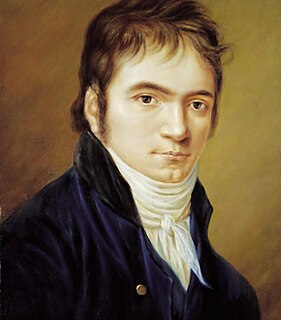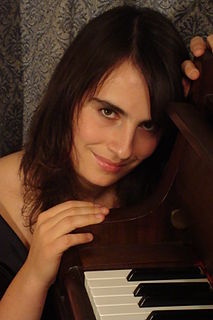Robert Wilfred Levick Simpson was an English composer and long-serving BBC producer and broadcaster.
Sergei Rachmaninoff's Piano Concerto No. 3 in D minor, Op. 30, was composed in the summer of 1909. The piece was premiered on November 28 of that year in New York City with the composer as soloist. The second performance of the concerto took place on January 16th, 1910 and featured Gustav Mahler conducting. The work often has the reputation of being one of the most technically challenging piano concertos in the standard classical piano repertoire.

The Piano Concerto No. 3 in C minor, Op. 37 is generally thought to have been composed in 1800, although the year of its composition has been questioned by some contemporary musicologists. It was first performed on 5 April 1803, with the composer as soloist. During that same performance, the Second Symphony and the oratorio Christ on the Mount of Olives were also premiered. The composition was published in 1804, and was dedicated to Prince Louis Ferdinand of Prussia. The first primary theme is reminiscent of that of Mozart's 24th Piano Concerto.
Sergei Prokofiev began his Violin Concerto No. 1 in D major, Op. 19, as a concertino in 1915 but soon abandoned it to work on his opera The Gambler. He returned to the concerto in the summer of 1917. It premiered on October 18, 1923 at the Paris Opera with Marcel Darrieux playing the violin part and the Paris Opera Orchestra conducted by Serge Koussevitzky. Igor Stravinsky made his debut as conductor at the same concert, conducting the first performance of his own Octet for Wind Instruments.
The Piano Concerto, Op. 38, by Samuel Barber was commissioned by the music publishing company G. Schirmer Inc. in honor of the centenary of their founding. The premiere was on September 24, 1962, in the opening festivities of Philharmonic Hall, now David Geffen Hall, the first hall built at Lincoln Center for the Performing Arts in Manhattan, with John Browning as soloist with the Boston Symphony Orchestra conducted by Erich Leinsdorf.
Robert Muczynski was a Polish-American composer.

Ludwig van Beethoven's Piano Concerto No. 1 in C major, Op. 15, was written in 1795, then revised in 1800. The first performance took place on 18 December 1795 in Vienna with Beethoven himself as soloist. It was first published in 1801 in Vienna with dedication to his pupil Princess Anna Louise Barbara Odescalchi, known to her friends as "Babette".
Arnold Atkinson Cooke was a British composer.

Pyotr Ilyich Tchaikovsky's Piano Concerto No. 3 in E-flat major, Op. posth. 75, was originally begun as a Symphony in E-flat. The composer ultimately abandoned this symphony, but, in 1893, started to rework it into a piano concerto, before abandoning all but the first movement, which he completed as a concert piece for piano and orchestra. It was published posthumously, in 1894, as a single-movement Allegro Brillante. The Symphony No. 6 Pathétique was the last of Tchaikovsky's compositions to be performed in his lifetime, but the Allegro Brillante, now known as the Piano Concerto No. 3, was his last completed composition.
Sadao Bekku was a Japanese classical composer. His works include five symphonies, film scores, a flute sonata, a piano concerto, choral work and art songs, and the opera, Prince Arima.

Lucijan Marija Škerjanc was a Slovene composer, music pedagogue, conductor, musician, and writer who was accomplished on and wrote for a number of musical instruments such as the piano, violin and clarinet. His style reflected late romanticism with qualities of expressionism and impressionism in his pieces, often with a hyperbolic artistic temperament, juxtaposing the dark against melodic phrases in his music.

Yoshirō Vladimir Irino was a Japanese composer.

Alissa Firsova is a Russian-British classical composer, pianist and conductor.

Sergiu Natra is an Israeli composer.
Milan Ristić was a Serbian composer, and a member of the Serbian Academy of Sciences and Arts.
Fantaisie for piano and orchestra (L.73/CD.72), is a composition for piano and orchestra by French composer Claude Debussy. It was composed between October 1889 and April 1890, but only received its first public performance in 1919, a year after Debussy's death. The work is dedicated to the pianist René Chansarel, who had been scheduled to play the solo part for the cancelled premiere in 1890.
Graham Whettam was an English post-romantic composer.
The Piano Concerto in C-sharp minor, Op. 45, is a composition for solo piano and orchestra in four movements by the American composer Amy Beach. The work was composed between September 1898 and September 1899. It was first performed in Boston on April 7, 1900, with the composer as the soloist and the Boston Symphony Orchestra performing under the conductor Wilhelm Gericke. The composition is dedicated to the musician Teresa Carreño and was the first piano concerto by an American female composer.
The Concerto for Piano and Orchestra is a piano concerto by the American composer John Corigliano. The work was commissioned by the San Antonio Symphony and was first performed on April 7, 1968 by the pianist Hilde Somer and the San Antonio Symphony under the direction of Victor Alessandro. The piece is dedicated to John Atkins.
The Concerto for Piano and Orchestra is a composition for solo piano and orchestra by the American composer Ellen Taaffe Zwilich. The work was written on a commission from Carnegie Hall, the Detroit Symphony Orchestra, and the League of American Orchestras. It was the first composition ever commissioned by either Carnegie Hall or the League of American Orchestras. The world premiere was performed by the pianist Marc-André Hamelin and the Detroit Symphony Orchestra under the direction of Günther Herbig at the Meadow Brook Music Festival in Rochester Hills, Michigan, on June 26, 1986. The piece is dedicated to Günther Herbig.